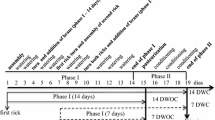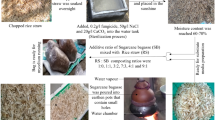Abstract
Eight lignocellulosic by-products were evaluated as substrates for cultivation of the oyster mushroom, Pleurotus ostreatus (Jacq. ex. fr) Kummer. The yields of mushroom on the different substrates were 183.1, 151.8, 111.5, 87.8, 49.5, 23.3, 13.0 and 0.0 g for composted sawdust of Triplochiton scleroxylon, rice straw, banana leaves, maize stover, corn husk, rice husk, fresh sawdust, and elephant grass, respectively. The biological efficiency (BE) followed the same pattern and ranged from 61.0% for composted sawdust to 0.0% for elephant grass. The yield of mushroom was positively correlated to cellulose (r 2 =0.6), lignin (r 2 =0.7) and fibre (r 2 =0.7) contents of the substrates. Based on the yield and BE of the substrates tested, rice straw appeared to be the best alternate substrate for growing oyster mushrooms.
Similar content being viewed by others
References
AOAC (1990) Official methods of analysis. Association of Official Analytical Chemists. Washington, D.C.
Auetrugal A (1984) The highest aspect for cultivating oak mushroom (Lentinula edodes) in plastic bags. Mushroom Newslett Tropics 5:11–15
Chang ST (1999) World production of mushrooms. Int J Med Mushroom 1:1–8
Garcha HS, Khanna PK, Soni GL (1993) Nutritional importance of mushrooms. In: Chang ST, Buswell JA, Chiu S (eds) Mushroom biology and mushroom products. Chinese University Press, Hong Kong
Mueller JC, Gawley JR, Hayes WA (1985) Cultivation of the shaggy mane mushroom (Coprinus comatus) on cellulosic residues from pulp mills. Mushroom Newslett Tropics 6:15–20
Oei P (1991) Manual on mushroom cultivation: techniques, species and opportunities for commercial application in developing countries. CTA, Wageningen, The Netherlands
Poppe J (2000) Use of agricultural waste materials in the cultivation of mushrooms. Mushroom Sci 15:3–23
Salmones D, Gerardo M, Ramos LM, Waliszewski KN (1999) Cultivation of shiitake mushroom, Lentinula edodes in several lignocellulosic materials originating from the tropics. Agronomie 19:13–19
SPSS (1999) SPSS 10 for Windows. SPSS, Chicago, III.
Thomas GV, Prabhu SR, Reeny MZ, Bopaiah BM (1998) Evaluation of lignocellulosic biomass from coconut palm as substrate for cultivation of Pleurotus sajor-caju (Fr.) Singer. World J Microbiol Biotechnol 14:879–882
Xiujin L, Yunzhi P, Zhang R (2000) Compositional changes of cottonseed hull substrate during P. ostreatus growth and the effects on the feeding value of the spent substrate. Bioresour Technol 80:157–161
Zadrazil F (1978) Cultivation of Pleurotus spp. In: Chang ST, Hayes WA (eds) The biology and cultivation of edible mushrooms. Chinese University Press, Hong Kong
Zhanzi L, Zhanhua L (1997) Jun-Cao technology. 2nd edn. pp 70–71
Acknowledgements
We thank Mr. K.G. Esiape and Messrs R. Takli and G. Agbeley for their technical assistance.
Author information
Authors and Affiliations
Corresponding author
Rights and permissions
About this article
Cite this article
Obodai, M., Cleland-Okine, J. & Vowotor, K.A. Comparative study on the growth and yield of Pleurotus ostreatus mushroom on different lignocellulosic by-products. J IND MICROBIOL BIOTECHNOL 30, 146–149 (2003). https://doi.org/10.1007/s10295-002-0021-1
Received:
Accepted:
Published:
Issue Date:
DOI: https://doi.org/10.1007/s10295-002-0021-1




